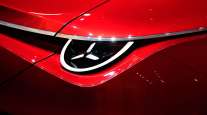Mercedes Updates Sprinter Van, Aims to Boost North American Sales
This story appears in the May 20 print edition of Transport Topics.
DUSSELDORF, Germany — Mercedes-Benz said it is taking aim at a larger portion of the North American market with its 2014 Sprinter delivery van, featuring a new engine and safety technologies.
A turbocharged 4-cylinder diesel engine and 7-speed automatic transmission come standard in the new model.
Company officials said here May 13 it offers an estimated 18% increase in fuel economy over the previous model with a 6-cylinder, 5-speed transmission that will still be offered as an option.
The 4-cylinder engine has been popular in Europe since its introduction in 2009, said Volker Mornhinweg, head of Mercedes-Benz Vans.
“With our new Sprinter, our customers in North America will also be able to profit with this excellent engine,” he said, noting the increased fuel economy and recommended service intervals of 15,000 miles, up from the current 10,000 miles.
In his opening remarks to the three dozen journalists attending the two-day press conference, test drive and assembly plant tour, Mornhinweg said the event was the first focused exclusively on North America.
“That shows how important this region has become for us,” he said.
Through April, Sprinter sales rose 12% in the United States from a year earlier, comprising 7.3% of the market, said Claus Tritt, general manager of commercial vehicles for Mercedes-Benz USA. April sales were up 20% year-over-year in Canada.
“The outlook for the USA is positive: There we expect another increase in the market for large vans,” parent firm Daimler AG said in its first-quarter earnings report. U.S. sales in the January-March period were 4,000. Worldwide sales were 52,600, just above the 51,200 sold a year earlier.
Mercedes-Benz has sold the Sprinter in the United States since 2010. Freightliner Trucks, also part of Daimler, has sold the van since its U.S. introduction in 2001. It was also previously built under the Dodge nameplate.
The Freightliner-branded Sprinter is receiving the same upgrades as Mercedes’ version. It goes on sale next month through a combined 219 dealerships in the United States and 49 in Canada. Deliveries are slated to begin in September.
Ford is the dominant company in the market, accounting for more than a 50% share. Chevrolet is second with about 30%.
Nearly 21,000 Sprinter vehicles were sold in the United States under the Mercedes and Freightliner nameplates last year, up from about 8,500 the year before. Mercedes accounts for about 80% of sales.
While declining to offer a specific sales target for the new model, Tritt said he was generally targeting an annual growth rate of about 5%.
Throughout the event, much of the attention was on safety technologies.
Mornhinweg called the new “crosswind assist,” which helps a driver maintain control of a vehicle when passing a large truck or crossing a bridge, “the world’s first system of its kind for vans.”
At a test track in Aldenhoven, about an hour south of the Dusseldorf assembly plant, journalists drove older Sprinter vehicles at speeds topping 60 mph past large wind fans and were literally blown into the next lane. But when taking the same ride in a new model, the push caused by the wind was far less severe and easily corrected with light steering.
Mornhinweg said this would be standard in U.S. models within a year.
A first-hand look at “collision prevention assist” also was offered. As journalists sat in passenger seats, a Sprinter drove behind an inflatable “car” being towed by another vehicle. As the Sprinter approached, a warning sounded, followed almost immediately by automatic brake assistance, helping the driver prevent a rear-end collision by a matter of inches.
Other technologies are “lane keeping assist” and the new “blind side assist” to reduce accidents during lane changes. In addition, the new “high beam assist” automatically uses brighter lighting on dark roads when no other vehicles are around.
Beyond the engine and safety technologies, Tritt touted the “bold, stylish and modern” styling of the new Sprinter. It features an updated front grille and headlamps that bring it more in line with Mercedes passenger vehicles and trucks.
Tritt said improving the exterior was particularly important step.
“At the end of the day, a van like this is a business card for customers,” Tritt said.
The Sprinter will continue to be produced at a two-level plant in Germany’s seventh-largest city. About 650 Sprinter vans are built each day over three shifts.
The production process begins on the upper level, and the vehicles are then finished on the ground floor. The inner-city location limits the company’s ability to expand the size of the plant.
Mornhinweg said the company will continue to break down most Sprinter vans produced here before being shipped by ocean to a reassembly plant in Charleston, S.C., to avoid U.S. tariffs. The passenger models are not subject to the tariffs and are shipped as completed vehicles.
Besides Sprinter, Crafter vans —a joint venture of Volkswagen and Daimler — are also produced at the plant. In total, workers handle more than 1,000 van variations with 14,000 different parts, Mornhinweg said.




